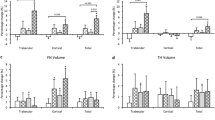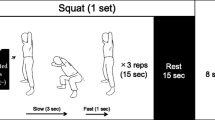Abstract
Summary
The rationale of this study was to examine the effectiveness of 6-month high-impact step aerobics (SA) or moderate-intensity resistance training exercise (RT) on bone mineral density (BMD) and bone bending strength in sedentary women. Results show that SA enhanced BMD in the heel, lower leg, and lumbar spine 2.
Introduction
To determine the effectiveness of 6 months of high-impact step aerobics (SA) or moderate-intensity resistance training (RT) on areal bone mineral density (aBMD) and tibial bending strength in sedentary premenopausal women.
Methods
Sixty-nine women (20–35 years old) who were randomly assigned to RT (n = 22), SA (n = 26), or non-treatment control (CON, n = 21) groups completed the study. SA had a minimum of 50 high-impact landings each training session. RT had a periodized lower body resistance training program incorporating eight exercises (65–85% of 1 repetition maximum: 1-RM). Both RT and SA met 3 times weekly. aBMD was assessed using dual X-ray absorptiometry (DXA). Tibial bending strength was assessed using mechanical response tissue analysis (MRTA). Measurements at 6 months were compared to baseline using ANCOVA, adjusted for baseline measures and covariates with α = 0.05.
Results
Calcaneus aBMD (0.0176 vs -0.0019 or -0.0009 g/cm2 relative to RT, p < 0.004, and CON, p < 0.006, respectively), lower leg aBMD (0.0105 vs -0.0036 g/cm2, relative to RT, p = 0.02), and lumbar spine 2 (L2) aBMD (0.0082 vs -0.0157 g/cm2 relative to CON, p < 0.02) were significantly greater in the SA group after 6 months. Tibial bending strength and bone resorption biomarkers were unchanged in all three groups after 6 months.
Conclusion
Sedentary premenopausal women engaging in 6 months of high-impact aerobic exercise improved aBMD in the calcaneus, lower leg, and L2.

Similar content being viewed by others
References
Burge R, Dawson-Hughes B, Solomon DH, Wong JB, King A, Tosteson A (2007) Incidence and economic burden of osteoporosis-related fractures in the United States, 2005–2025. J Bone Miner Res 22:465–475
Vainionpää A, Korpelainen R, Leppäluoto J, Jämsä T (2005) Effects of high-impact exercise on bone mineral density: a randomized controlled trial in premenopausal women. Osteoporos Int 16:191–197
Gordon CM, Zemel BS, Wren TA, Leonard MB, Bachrach LK, Rauch F et al (2016) The determinants of peak bone mass. J Pediatrics 180:261–269. https://doi.org/10.1016/jjpeds.2016.09.056
Riggs BL, Melton L Jr (1992) The prevention and treatment of osteoporosis. N Engl J Med 327:620–627
Marcus R, Greendale G, Blunt BA et al (1994) Correlates on bone mineral density in postmenopausal estrogen/progestin intervention trial. J Bone Miner Res 9:1467–1476
Center JR, Nguyen TV, Schneider D et al (1999) Mortality after all major types of osteoporotic fracture in men and women: an observational study. Lancet 353:878–882
Siris ES, Miller PD, Barrett-Connor E, Faulkner KG, Wehren LE, Abbott TA et al (2001) Identification and fracture outcomes of undiagnosed low bone mineral density in postmenopausal women: results from the National Osteoporosis Risk Assessment. JAMA 286:2815–2822
Hauselmann HJ, Rizzoli R (2003) A comprehensive review of treatment for postmenopausal osteoporosis. Osteoporos Int 14:2–12
Liang MTC, Bruan W, Basin SL, Dutton D, Pontello A, Wong ND, Spalding TW, Arnaud SB (2011) Effect of high-impact aerobics and strength training on BMD in young women aged 20–35 years. Int J Sports Med 32:100–108
Kelley GA, Kelley KS, Kohrt WM (2013) Exercise and bone mineral density in premenopausal women: a meta-analysis of randomized controlled trials. Int J Endocrinol 2013:741639. https://doi.org/10.1155/2013/741639
Gourlay MC, Brown SA (2004) Clinical considerations in premenopausal osteoporosis. Arch Intern Med 164:603–606
Taaffe DR, Robinson TL, Snow CM, Marcus R (1997) High-impact exercise promotes bone gain in well-trained female athletes. J Bone Miner Res 12:255–260
Friedlander AL, Genant HK, Sadowsky S, Byl NN, Glüer CC (1995) A two-year program of aerobics and weight training enhances bone mineral density of young women. J Bone Miner Res 10:574–585
Gleeson PB, Protas EJ, LeBlanc AD, Schneider VS, Evans HJ (1990) Effects of weight lifting on bone mineral density in premenopausal women. J Bone Miner Res 5:153–158
Vuori I, Heinonen A, Sievänen H, Kannus P, Pasanen M, Oja P (1994) Effects of unilateral strength training and detraining on bone mineral density and content in young women: a study of mechanical loading and deloading on human bones. Calcif Tissue Int 55:59–67
Bassey EJ, Ramsdale SJ (1995) Weight-bearing exercise and ground reaction forces: a 12-month randomized controlled trial of effects on bone mineral density in healthy postmenopausal women. Bone 16:469–476
Bassey EJ, Rothwell MC, Littlewood JJ, Pye DW (1998) Pre- and postmenopausal women have different bone mineral density responses to the same high-impact exercise. J Bone Miner Res 13:1805–1813
Heinonen A, Kannus P, Sievänen H, Oja P, Pasanen M, Rinne M, Uusi-Rasi K, Vuori I (1996) Randomised controlled trial of effect of high-impact exercise on selected risk factors for osteoporotic fractures. Lancet 348:1343–1347
Liang MTC, Arnaud SB, Steele CR, Hatch P, Moreno A (2005) Ulnar and tibial bending stiffness as an index of bone strength in synchronized swimmers and gymnasts. Eur J Appl Physiol 94:400–407
Hutchinson TM, Bakulin AV, Rakhmanov AS, Martin RB, Steele CR, Arnaud SB (2001) Effects of chair restraint on the strength of tibia in rhesus monkeys. J Med Primatol 30:313–321
Kiebzak GM, Box JH, Box P (1999) Decreased ulnar bending stiffness in osteoporotic Caucasian women. J Clin Densitom 2:143–152
Steele CR, Zhou L-Z, Guido D, Marcus R, Heinrichs WL (1988) Cheema C Noninvasive determination of ulnar stiffness from mechanical response – in vivo comparison of stiffness and bone mineral content in humans. J Biomech Eng 110:87–96
Arnaud SB, Steele CR, Zhou L-J, Hutchinson T (1991) Marcus R (1991) A direct non-invasive measure of long bone strength. Proc Ann Int Cong IEEE Eng Int Med Biol Soc 13:1984–1985
Roberts SG, Hutchson TM, Arnaud SB, Kirati BJ, Martin RB (1996) Steele CR (1996) Noninvasive determination of bone mechanical properties using vibration response: a refined model and validation in vivo. J Biomech 29(1):91–98
American College of Sport Medicine, ACSM’s guideline for exercise testing and prescription, 10th edn. Wolters Kluwer, Philadelphia, p 4–8
Thomas JR, Nelson JK (2001) Research methods in physical activity, 4th edn. Human Kinetics, Champaign, p 138–140
Vainionpää A, Korpelainen R, Vihriala E, Rinta-Paavola A, Leppaluoto J, Jamsa T (2006) Intensity of exercise is associated with bone density change in premenopausal women. Osteoporos Int 17:455–463
Bassey EJ, Ramsdale SJ (1994) Increase in femoral bone density in young women following high-impact exercise. Osteoporos Int 4:72–75
Heinonen A, Sievänen H, Kannus P, Oja P, Vuori I (1996) Effects of unilateral strength training and detraining on bone mineral mass and estimated mechanical characteristics of the upper limb bones in young women. J Bone Miner Res 11:490–501
Frost HM (2003) Bone’s mechanostat: a 2003 update. Anat Rec A Discov Mol Cell Evol Biol 275:1081–1101
Stone MH (1990) Muscle conditioning and muscle injuries. Med Sci Sports Exerc 22:457–462
Pruitt LA, Taaffe DR, Marcus R (1995) Effects of a one-year high-intensity versus low-intensity resistance training program on bone mineral density in older women. J Bone Miner Res 10:1788–1795
Heinonen A, Oja P, Kannus P, Sievänen H, Mänttäri A, Vuori I (1993) Bone mineral density of female athletes in different sports. Bone Mineral 23:1–14
Tsuzuku S, Ikegami Y, Yabe K (1998) Effects of high-intensity resistance training on bone mineral density in young male powerlifters. Calcif Tissue Int 63:283–286
Chilibeck PD, Calder A, Sale DG, Webber CE (1996) Twenty weeks of weight training increases lean tissue mass but not bone mineral mass or density in healthy, active young women. Canadian J Physiol and Pharmaco 74:1180–1185
Sinaki M, Wahner HW, Bergstralh EJ, Hodgson SF, Offord KP, Squires RW, Swee RG, Kao PC (1996) Three-year controlled, randomized trial of the effect of dose-specified loading and strengthening exercises on bone mineral density of spine and femur in nonathletic, physically active women. Bone 19:233–244
Wang Q, Nicholson PH, Suuriniemi M, Lyytikainen A, Helkala E et al (2004) Relationship of sex hormones to bone geometric properties and mineral density in early pubertal girls. J Clin Endocrinol Metab 89(4):1698–1703
Ammann PR, Rizzoli R (2003) Bone strength and its determinant. Osteoporos Int 14:13–18
Acknowledgements
We would like to acknowledge Dr. Scott Stevenson who designed the resistance training program; our graduate students for their assistance in the project; and the participants for their time, effort, and commitment in completing the study.
Funding
This project was supported by The National Institutes of Health Grant GM053933-06 to M.T.C.L., D.J.D., W.A.B., and S.L.B.
Author information
Authors and Affiliations
Corresponding author
Ethics declarations
Conflicts of interest
None.
Additional information
Publisher's note
Springer Nature remains neutral with regard to jurisdictional claims in published maps and institutional affiliations.
Rights and permissions
About this article
Cite this article
Dutto, D.J., Liang, M.T.C., Braun, W.A. et al. Effect of 6-month high-impact step aerobics and resistance training on BMD and tibial bending strength in sedentary premenopausal women. Osteoporos Int 33, 695–701 (2022). https://doi.org/10.1007/s00198-021-06106-y
Received:
Accepted:
Published:
Issue Date:
DOI: https://doi.org/10.1007/s00198-021-06106-y




